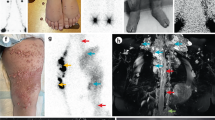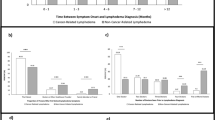Abstract
Turner syndrome is a complex disorder caused by an absent or abnormal sex chromosome. It affects 1/2000–1/3000 live-born females. Congenital lymphoedema of the hands, feet and neck region (present in over 60% of patients) is a common and key diagnostic indicator, although is poorly described in the literature. The aim of this study was to analyse the medical records of a cohort of 19 Turner syndrome patients attending three specialist primary lymphoedema clinics, to elucidate the key features of the lymphatic phenotype and provide vital insights into its diagnosis, natural history and management. The majority of patients presented at birth with four-limb lymphoedema, which often resolved in early childhood, but frequently recurred in later life. The swelling was confined to the legs and hands with no facial or genital swelling. There was only one case of suspected systemic involvement (intestinal lymphangiectasia). The lymphoscintigraphy results suggest that the lymphatic phenotype of Turner syndrome may be due to a failure of initial lymphatic (capillary) function.
Similar content being viewed by others
Log in or create a free account to read this content
Gain free access to this article, as well as selected content from this journal and more on nature.com
or
References
Wolff DJ, Van Dyke DL, Powell CM : Working Group of the ACMG Laboratory Quality Assurance Committee Laboratory guideline for Turner syndrome. Genet Med 2010; 12: 52–55.
Gunther DF, Sybert VP : Lymphatic, tooth and skin manifestations in Turner syndrome. Int Congr Ser 2006; 1298: 58–62.
Zhong Q, Layman LC : Genetic considerations in the patient with Turner syndrome - 45,X with or without mosaicism. Fertil Steril 2012; 98: 775–779.
Matura LA, Ho VB, Rosing DR, Bondy CA : Aortic dilatation and dissection in Turner syndrome. Circulation 2007; 116: 1663–1670.
Sybert VP, McCauley E : Turner's Syndrome. N Engl J Med 2004; 351: 1227–1238.
Morgan T : Turner syndrome: diagnosis and management. Am Fam Physician 2007; 76: 405–410.
Oliveira RM, Verreschi IT, Lipay MV, Eça LP, Guedes AD, Bianco B : Y chromosome in Turner syndrome: review of the literature. Sao Paulo Med J 2009; 127: 373–378.
Rizell S : Dentofacial morphology in Turner syndrome karyotypes. Swed Dent J Suppl 2012; 225: 7–98.
Connell FC, Gordon K, Brice G et al: The classification and diagnostic algorithm for primary lymphatic dysplasia: an update from 2010 to include molecular findings. Clin Genet 2013; 84: 303–314.
Gordon K, Spiden SL, Connell FC et al: FLT4/VEGFR3 and Milroy disease: novel mutations, a review of published variants and database update. Hum Mutat 2013; 34: 23–31.
Keeley V : The use of lymphoscintigraphy in the management of chronic oedema. J Lymphoedema 2006; 1: 42–57.
von Kaisenberg CS, Wilting J, Dörk T et al: Lymphatic capillary hypoplasia in the skin of fetuses with increased nuchal translucency and Turner's syndrome: comparison with trisomies and controls. Mol Hum Reprod 2010; 16: 778–789.
Canki N, Warburton D, Byrne J : Morphological characteristics of monosomy X in spontaneous abortions. Ann Genet 1988; 31: 4–13.
Elsheikh M, Dunger DB, Conway GS, Wass JA : Turner's syndrome in adulthood. Endocr Rev 2002; 23: 120–140.
Lowenstein EJ, Kim KH, Glick SA : Turner's syndrome in dermatology. J Am Acad Dermatol 2004; 50: 767–776.
Welsh J, Todd M : Incidence and Characteristics of lymphedema in Turner’s Syndrome. Lymphology 2006; 39: 152–153.
Bellini C, Di Battista E, Boccardo F et al: The role of Lymphoscintigraphy in the Diagnosis of Lymphedema in Turner Syndrome. Lymphology 2009; 42: 123–129.
Boucher CA, Sargent CA, Ogata T, Affara NA : Breakpoint analysis of Turner patients with partial Xp deletions: implications for the lymphoedema gene location. J Med Genet 2001; 38: 591–598.
Ogata T, Muroya K, Matsuo N et al: Turner syndrome and Xp deletions: clinical and molecular studies in 47 patients. J Clin Endocrinol Metab 2001; 86: 5498–5508.
Ogata T, Tyler-Smith C, Purvis-Smith S, Turner G : Chromosomal localisation of a gene(s) for Turner stigmata on Yp. J Med Genet 1993; 30: 918–922.
Lymphoedema Framework. Best Practice for the Management of Lymphoedema. International consensus. London: MEP Ltd 2006. Available at http://www.lympho.org/mod_turbolead/upload/file/Lympho/Best_practice_20_July.pdf.
Mellor RH, Hubert CE, Stanton AW et al: Lymphatic dysfunction, not aplasia, underlies Milroy disease. Microcirculation 2010; 17: 281–296.
Brice G, Child AH, Evans A et al: Milroy disease and the VEGFR-3 mutation phenotype. J Med Genet 2005; 42: 98–102.
Acknowledgements
We extend our thanks to the patients and their families and the British Heart Foundation for funding the work of Dr Kristiana Gordon (FS/11/40/28739) and Dr Pia Ostergaard (PG/10/58/28477).
Author information
Authors and Affiliations
Corresponding author
Ethics declarations
Competing interests
The authors declare no conflict of interest.
Rights and permissions
About this article
Cite this article
Atton, G., Gordon, K., Brice, G. et al. The lymphatic phenotype in Turner syndrome: an evaluation of nineteen patients and literature review. Eur J Hum Genet 23, 1634–1639 (2015). https://doi.org/10.1038/ejhg.2015.41
Received:
Revised:
Accepted:
Published:
Issue date:
DOI: https://doi.org/10.1038/ejhg.2015.41
This article is cited by
-
Turner syndrome: French National Diagnosis and Care Protocol (NDCP; National Diagnosis and Care Protocol)
Orphanet Journal of Rare Diseases (2022)
-
Primary lymphoedema
Nature Reviews Disease Primers (2021)
-
Primäre intestinale Lymphangiektasie und proteinverlierende Enteropathie bei Kindern und Jugendlichen
Monatsschrift Kinderheilkunde (2021)
-
Chromosomal Abnormalities Affect the Surgical Outcome in Infants with Hypoplastic Left Heart Syndrome: A Large Cohort Analysis
Pediatric Cardiology (2018)
-
Intestinal lymphatic vasculature: structure, mechanisms and functions
Nature Reviews Gastroenterology & Hepatology (2017)



